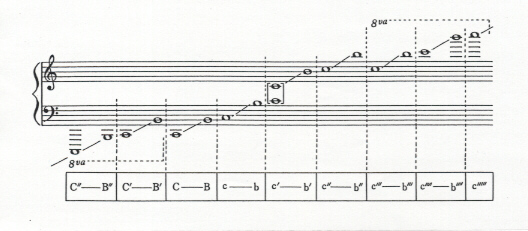
INTRODUCTORY REMARKS
Basis of Ordering Instruments
The instruments in this catalog are grouped in five categories based on the Hornbostel= Sachs classification, and each group is arranged more or less according to the external appearance of the instruments.
Order of Entries in the Descriptions
|
316 rebab
Indonesia=Jawa body: wood, with parchment of water buffalo bladder over the front face: L.113.7cm. soundholes: 5, in the middle of the back; string:2, brass bridge: 1 bow: 1 range: ca.2 1/2oct.from c; tuning: c-g The player sits cross-legged and holds the instrument vertically,in front of him. The bow is held in the right hand and the tension of the bow hair is regulated by pressure with the fingers. To reduce upper partials and thereby soften the tone quality, banana leaves more (recently tissue paper) are inserted between the two strings near the bridge. Used in gamelan ensembles wayang kulit. Used in accompaniment and various song and dance styles. |
1. Catalog
Number
2. Name of
Instrument
As a general rule pronunciation and
spelling (romanization) is based on usage in the area. In cases where the name
is not known, a generic name has been inserted in brackets. When a proper name
cannot be determined, a question mark has been added. Ex. Shakuhachi?,
[transverse flute], etc.
3. Name of
Area, Name of Ethnic Group
When
the instrument is from an area whose name or ethnic group is known, the name of
the broad area or country is listed first, followed by the narrower
specification. Name of country (name of specific area) name of ethnic
group. Ex. Philippines
(Luzon)=Kalinga; Central Asia= Tajik, etc.
When a
proper name could not be determined, a question mark has been added.
4. Material,
Size
Wherever
identified, materials used to construct the instrument are specified. As a
general rule, the size indicates the length of the entire instrument. However,
in the case of membranophones both the length of the body or frame and the diameter
of the membrane are given. Only the materials used in the main parts of the
instrument are indicated.
5. Other Data
(Frets, Strings, Holes, Tuning, Range, Lowest Pitch of Pipes, Accessories,
etc.)
Pitch
names: as indicated below

Tuning: When several tunings are
possible, a typical one has been shown. Pitch names given do not necessarily represent
absolute pitch.
Tuning of
zithers: indicated in the order from the string closest to the player to the
string farthest away.
Tuning
of lutes: from left to right, looking at the surface (the area over which strings
are stretched) with
theneck
pointing upwards
Finger holes: for wind
instruments., the hole farthest from the mouth hole is considered the first
hole.
Accessories: Only those
accessories that are directly related to performance, such as plectra, mallets,
tuning keys, etc. are indicated.
6. Explanatory
Notes
N.B. The
smallest increment on the scale included in each photograph represents one
centimeter
Back to Contents


